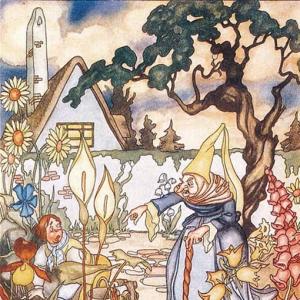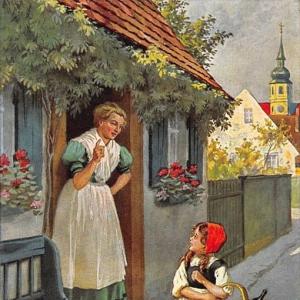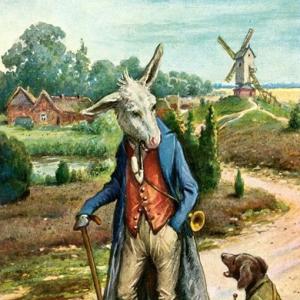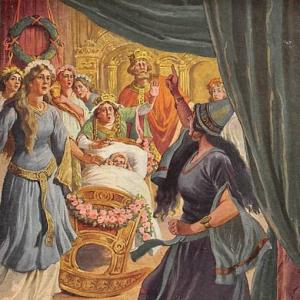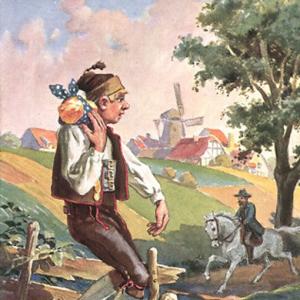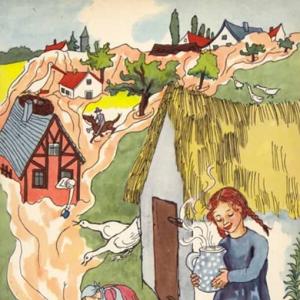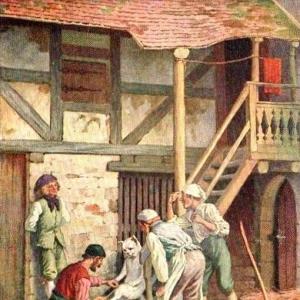Reading time for children: 4 min
There was once a poor woman who had a son, who much wished to travel, but his mother said, „How canst thou travel? We have no money at all for thee to take away with thee.“ Then said the son, „I will manage very well for myself. I will always say, Not much, not much, not much.“
So he walked for a long time and always said, „Not much, not much, not much.“ Then he passed by a company of fishermen and said, „God speed you! not much, not much, not much.“
„What sayst thou churl, not much?“‚ And when the net was drawn out they had not caught much fish. So one of them fell on the youth with a stick and said, „Hast thou never seen me threshing?“
„What ought I to say, then?“ asked the youth. „Thou must say, Get it full, get it full.“ After this he again walked a long time, and said, „Get it full, get it full,“ until he came to the gallows, where they had got a poor sinner whom they were about to hang. Then said he, „Good morning. Get it full, get it full.“
„What sayst thou, knave, get it full? Dost thou want to make out that there are still more wicked people in the world is not this enough?“ And he again got some blows on his back. „What am I to say, then?“ said he. „Thou must say, may God have pity on the poor soul.“
Again the youth walked on for a long while and said, „May God have pity on the poor soul!“ Then he came to a pit by which stood a knacker who was cutting up a horse. The youth said, „Good morning. God have pity on the poor soul!“
„What dost thou say, thou ill-tempered knave?“ and the knacker gave him such a box on the ear, that he could not see out of his eyes. „What am I to say, then?“ – „Thou must say, There lies the carrion in the pit!'“
So he walked on, and always said, „There lies the carrion in the pit, there lies the carrion in the pit.“ And he came to a cart full of people, so he said, „Good morning, there lies the carrion in the pit!“
Then the cart pushed him into a hole, and the driver took his whip and cracked it upon the youth, till he was forced to crawl back to his mother, and as long as he lived he never went out a-travelling again.
 Learn languages. Double-tap on a word.Learn languages in context with Childstories.org and Deepl.com.
Learn languages. Double-tap on a word.Learn languages in context with Childstories.org and Deepl.com.Backgrounds
Interpretations
Adaptions
Summary
Abstract
Linguistics
„Going a Traveling“ is a lesser-known German fairy tale collected by the Brothers Grimm in their famous collection, Grimm’s Fairy Tales. The tale is categorized as Aarne-Thompson type 1696, What Should I Have Said?, which typically deals with stories where the protagonist tries to use the right words or phrases but finds themselves in trouble or confusion because of it.
The Brothers Grimm, Jacob and Wilhelm, were German scholars and linguists who collected and published German and European folk tales during the 19th century. Their work aimed to preserve the oral traditions of storytelling and provide a sense of cultural identity and history to the German people. The stories they collected often contained moral lessons, elements of fantasy, and were passed down through generations.
„Going a Traveling“ reflects several themes commonly found in fairy tales, such as the journey or adventure, the impact of words, and the importance of learning from experience. The story serves as a cautionary tale that highlights the importance of understanding the context in which certain phrases are used, as well as the potential consequences of using the wrong words.
The Brothers Grimm aimed to preserve the rich oral tradition of German folklore by documenting these tales in written form. Their stories have been reinterpreted, adapted, and translated into various languages and mediums over the years, making them an essential part of global literature and popular culture. „Going a Traveling,“ like many other Grimm’s fairy tales, incorporates elements of folklore, morality, and life lessons. The story features a naive and inexperienced protagonist, whose encounters with different characters and situations provide him with valuable lessons, often through harsh consequences. The tale is an example of a cautionary story that teaches readers the importance of understanding context, communication, and learning from experiences.
The protagonist’s journey in „Going a Traveling“ may be seen as a metaphor for the experiences people encounter throughout their lives. Each situation the protagonist encounters represents a different challenge or lesson, emphasizing the importance of adapting to new circumstances and learning from them. Though „Going a Traveling“ is not as well-known as some of the Grimm Brothers‘ other stories, it remains a part of their rich collection of fairy tales that continue to be appreciated for their cultural, historical, and literary significance.
In summary, the background of the fairy tale „Going a Traveling“ by the Brothers Grimm can be traced back to its origins in German oral storytelling traditions. It explores themes of personal growth, the power of language, and the importance of understanding the context in which words are used, which are common motifs in many fairy tales.
Various interpretations can be drawn from the fairy tale „Going a Traveling“ by the Brothers Grimm. While the story may seem simple on the surface, it offers deeper messages and lessons to be gleaned. Here are some possible interpretations:
The power of words: The story highlights the power that words and phrases hold in different situations. The protagonist’s use of the phrases leads to unintended consequences, demonstrating that words can have a significant impact on people’s lives and the world around them.
The importance of context: The tale emphasizes the importance of understanding the context in which words and phrases are used. Each time the protagonist encounters a new situation, he learns that the phrases he used previously are not suitable for the new context. The story thus serves as a reminder that what might be appropriate in one situation may not be fitting in another.
The journey of self-discovery: As the protagonist embarks on his journey, he is confronted with various challenges and lessons. This journey can be seen as a metaphor for life, where individuals learn and grow from their experiences. The story highlights the importance of personal growth, resilience, and adapting to new circumstances.
The consequences of ignorance: The protagonist’s repeated use of inappropriate phrases in different situations underscores the potential negative consequences of ignorance. The story serves as a cautionary tale, warning readers to be mindful of their words and actions to avoid causing harm to others or themselves.
The value of experience: Through his journey, the protagonist learns valuable lessons and returns home a wiser person. The story highlights the importance of learning from experiences and understanding the consequences of one’s actions.
The importance of context and communication: The young man repeats phrases without understanding their meaning or considering the context in which they are being used. This highlights the importance of being aware of one’s surroundings and adapting communication to suit different situations.
Learning from experiences: Each time the young man is punished, he learns a new phrase to use in his journey. Although the outcomes are often unfavorable, the story emphasizes the importance of learning from one’s experiences and mistakes.
The danger of blindly following advice: The young man continuously takes the advice of strangers without questioning the appropriateness of their suggestions. This teaches readers to be cautious about following advice without considering its validity or implications.
The value of wisdom and experience: The young man’s mother warns him against traveling, but he disregards her advice. Her concerns prove to be justified, and the story emphasizes the importance of listening to and learning from the wisdom and experiences of others, particularly from older generations.
Resilience and adaptation: The young man faces numerous challenges and adversities during his journey, but he perseveres and adapts. This can be seen as a metaphor for life, where one must continuously learn, adapt, and grow in the face of setbacks.
In conclusion, the fairy tale „Going a Traveling“ by the Brothers Grimm offers multiple interpretations, each highlighting different aspects of human behavior, the power of language, and the importance of personal growth. By examining these themes, readers can gain insights into the lessons embedded within the story and apply them to their own lives. In summary, „Going a Traveling“ teaches the importance of effective communication, learning from experiences, critically evaluating advice, valuing wisdom from others, and developing resilience and adaptability in the face of life’s challenges.
„Going a Traveling“ is a lesser-known fairy tale from the Brothers Grimm, who were German scholars, linguists, and authors. Jacob and Wilhelm Grimm collected and published hundreds of folktales, stories, and legends in the early 19th century. Their collection of stories, known as „Grimm’s Fairy Tales“ or „Children’s and Household Tales“ (in German: „Kinder- und Hausmärchen“), includes famous stories such as „Cinderella,“ „Snow White,“ and „Hansel and Gretel.“ While „Going a Traveling“ is a lesser-known tale from the Brothers Grimm collection, there have been some adaptations and reinterpretations of the story. These adaptations may not follow the original tale closely, but they often share similar themes and motifs. Here are some examples.
Picture books: „The Wise Fool“ by Heather Forest: This picture book adaptation, targeted at children, tells the story of Nasreddin Hodja, a wise fool character from Middle Eastern and Central Asian folklore. The tale follows Nasreddin Hodja as he travels from one village to another, giving advice and getting into trouble. The story shares themes with „Going a Traveling,“ such as the power of words, the importance of context, and learning from one’s experiences. „It Could Always Be Worse“ by Margot Zemach: This picture book is an adaptation of a Yiddish folktale that shares the theme of perspective and the power of words. The story follows a poor man who complains about his living conditions. He is advised to bring more and more animals into his house, and eventually realizes that his initial situation was not as bad as he thought. While not a direct adaptation of „Going a Traveling,“ it shares the theme of learning from experience and understanding the importance of context.
Literature: „The Traveler“ by Richard Siken: This poem, featured in his poetry collection „Crush,“ can be seen as a loose adaptation or interpretation of „Going a Traveling.“ The poem follows the speaker as they recount various encounters during their travels, emphasizing the significance of language and its impact on others. Although the poem is not a direct retelling of the fairy tale, it shares thematic similarities and can be viewed as an adaptation of the story’s core ideas.
Short films and animations: Some independent filmmakers and animators have created short films or animations based on or inspired by „Going a Traveling.“ While these adaptations may not have achieved widespread recognition, they often explore the story’s themes, such as the power of words, the importance of context, and the journey of self-discovery.
Overall, adaptations of „Going a Traveling“ may not be as numerous as those of more well-known Grimm fairy tales, but the story’s themes have found their way into various forms of media, from picture books to poetry and film. These adaptations often reinterpret the story to emphasize its universal messages, making the tale relevant to new generations of readers and audiences.
„Going a Traveling“ is a German fairy tale collected by the Brothers Grimm that follows the journey of a young man who decides to go traveling, despite his mother’s concerns. He reassures her by promising to always say „not much“ during his travels. As he journeys, he encounters various people who react negatively to the phrases he utters, leading him to change his words each time.
First, he meets a group of fishermen who are unable to catch any fish. They become angry at his phrase „not much“ and tell him to say „Get it full“ instead. The young man continues his journey, repeating „get it full,“ until he encounters an executioner at a gallows, who becomes annoyed and tells him to say „God, please have pity on the poor soul.“
Next, the protagonist encounters a group of knackers skinning a horse while he repeats the new phrase. They become angry and instruct him to say „there lies the dead flesh in the pit.“ As he continues using these words, a cart falls into a pit nearby, and the people in the cart blame the young man’s words for their misfortune. They attack him, forcing him to flee back home, where he vows never to go out traveling again.
The story serves as a cautionary tale, highlighting the power and impact of words, the importance of understanding the context in which they are used, and the value of learning from one’s experiences.
„Going a Traveling“ is a Brothers Grimm fairy tale about a poor young man who wishes to travel the world. His mother worries they don’t have enough money, but the son decides to embark on the journey anyway, repeating the phrase „Not much, not much, not much.“ Throughout his journey, the young man encounters different people and situations, where he unknowingly speaks phrases that offend or upset those he meets.
First, he comes across fishermen, and wishing them „not much“ results in them catching very few fish. He is beaten and told to say, „Get it full, get it full“ instead. As he continues his journey, he repeats this new phrase and eventually encounters a group of people preparing to hang a criminal. They are angered by his words and beat him again, instructing him to say, „May God have pity on the poor soul.“
The young man carries on, using the phrase he was last taught, and encounters a knacker cutting up a horse by a pit. The knacker is enraged by the phrase, hits the youth, and tells him to say, „There lies the carrion in the pit!“ The young man continues his journey, repeating this new phrase, until he meets a cart full of people. After saying the phrase to them, he is pushed into a hole and beaten by the cart driver.
The unfortunate experiences during his journey teach the young man a lesson. He crawls back to his mother, never venturing out to travel again, having learned the importance of understanding and using appropriate language in different situations.
An analysis of the Brothers Grimm fairy tale „Going A Traveling“ reveals several linguistic and thematic elements that are emblematic of their storytelling style.
Let’s break down some of these components
Repetition: Phrases such as „Not much, not much, not much“ and „Get it full, get it full“ are repeated multiple times. This repetitive structure serves as a mnemonic device, making the tale more engaging and memorable. It also underscores the folly of the youth’s simplistic understanding of communication.
Dialogues and Direct Speech: The story uses direct speech extensively, which is typical of oral storytelling traditions. This technique allows characters’ personalities to shine through their dialogues and keeps the narrative dynamic.
Simple and Direct Language: The language used is straightforward, with simple sentences. This accessibility in language ensures that the moral lessons are clear and easily understood by readers of all ages.
Use of Archaic Vocabulary: Words like „thou,“ „sayst,“ and „knave“ give the narrative an antiquated feel, connecting modern readers to a bygone era and emphasizing the traditional nature of fairy tales.
Thematic Elements
Folly and Innocence: Central to the tale is the theme of naivety. The youth’s literal interpretation of phrases and his blind adherence to them highlight human folly in the face of complex social norms and interactions.
Consequences and Learning: The story is structured around a cause-and-effect pattern. The youth’s mistakes lead to negative consequences (e. g. , physical punishment). This is a common motif in fairy tales where protagonists learn lessons through their misadventures and the resulting consequences.
Authority and Punishment: Authority figures (fishermen, executioner, knacker) maintain social order through punishment, illustrating a moral structure where deviations from societal norms are met with repercussions.
Moral and Didactic Purpose: As with many Grimm tales, this story serves a didactic purpose. It emphasizes the importance of understanding context and the appropriate use of language in different situations. The youth’s journey symbolizes the transition from ignorance to a hard-earned wisdom.
Travel as a Metaphor for Life: The youth’s desire to travel reflects a deeper yearning for life experiences. His journey represents the trials and tribulations encountered during life’s explorations.
Structural Features
Cyclical Structure: The protagonist begins and ends at home, symbolizing a journey completed, albeit with learned lessons instead of worldly gain. This cyclical narrative reinforces the idea that some individuals are perhaps best suited to a simpler, less adventurous life.
Progressive Escalation: Each encounter increases in severity, demonstrating an escalating complexity in social interactions which the youth fails to navigate.
In conclusion, „Going A Traveling“ weaves together linguistic elements, thematic substance, and structural patterns to impart a moral lesson on the value of social wisdom and the consequences of naivety. Through its exploration of language and societal norms, it holds a mirror to human behavior, encouraging readers to glean wisdom from the protagonist’s misadventures.
Information for scientific analysis
Fairy tale statistics | Value |
|---|---|
| Number | KHM 143 |
| Aarne-Thompson-Uther-Index | ATU Typ 1696 |
| Translations | DE, EN, DA, ES, FR, PT, IT, JA, NL, PL, RU, TR, VI, ZH |
| Readability Index by Björnsson | 16.6 |
| Flesch-Reading-Ease Index | 97.4 |
| Flesch–Kincaid Grade-Level | 2.8 |
| Gunning Fog Index | 5.7 |
| Coleman–Liau Index | 5.4 |
| SMOG Index | 5.9 |
| Automated Readability Index | 1.8 |
| Character Count | 2.122 |
| Letter Count | 1.543 |
| Sentence Count | 34 |
| Word Count | 428 |
| Average Words per Sentence | 12,59 |
| Words with more than 6 letters | 17 |
| Percentage of long words | 4% |
| Number of Syllables | 489 |
| Average Syllables per Word | 1,14 |
| Words with three Syllables | 7 |
| Percentage Words with three Syllables | 1.6% |






